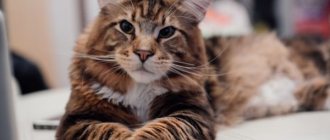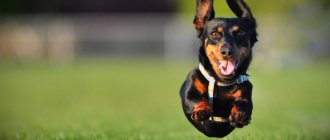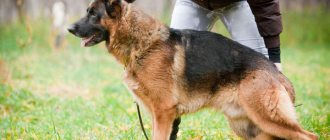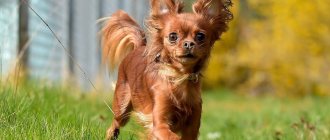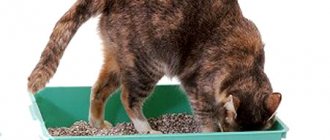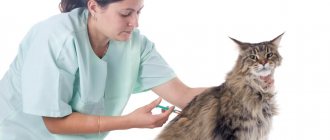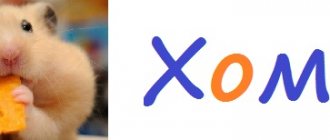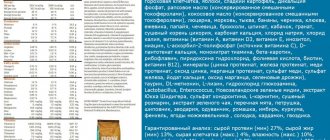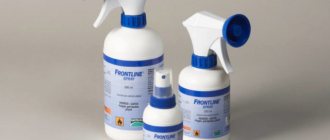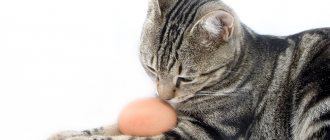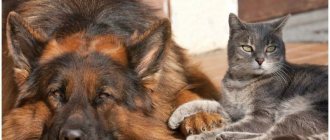Description of the Maine Coon breed
Popularity 4th place among 87 cat breeds
Lifespan:
12-15 years
Height:
25-41 cm
Country of origin:
USA
Average price:
20-40 thousand rubles
Weight:
4-12 kg
Latest articles Cat health
Ataxia in cats: what it is, how it manifests itself and is treated 01/23/2022 173 0 0
Cat health
Leukemia, or viral leukemia in cats 01/23/2022 152 0 0
Key facts
The Maine Coon is one of the most unusual and fascinating cat breeds in the modern world. They can be called a lazy breed, although they are not averse to engaging in some active play with other family members.
The description of the Maine Coon breed says that it originated in the USA back in the 19th century. These representatives of pets occupy first place in size among other cat breeds.
This breed is easy to care for, despite its rather long and fluffy coat. It is not necessary to take them for grooming; regular combing at home is also suitable.
The characteristics of the Maine Coon are as follows: they are one of the most affectionate, kind and affectionate. Coons are good with children and other pets, make contact easily and are not afraid of guests. It is worth noting the high intelligence of cats, thanks to which they are easy to train.
Due to their thick and fluffy coat, which repels water, Maine Coons are able to withstand frost. This is also facilitated by the presence of pads that have spring functions and help you move easily through snowdrifts. But at the same time, they can easily withstand very high temperatures, so there is no need to cut the coon for the summer.
Having become interested in something, these felines take a rather amusing and funny pose: they stand on their hind legs and look with surprise on their faces at the object that attracts their attention.
The health and life expectancy of the Maine Coon are high; giant cats can live 14-15 years.
History of the origin of the Maine Coon
The breed was developed in America two centuries ago. There is a very interesting and entertaining legend associated with the name of the breed. With the first part of the phrase, everything is extremely simple: Maine is the name of the state where the breed was bred (Maine). Thanks to the long and fluffy tail, a legend arose that the ancestors of cats were crossed with a raccoon. Hence the second part of the word - kun (short for English racoon - raccoon).
How did Maine Coon cats appear in America? Historians believe that representatives of the short-haired breed were first brought to America. And a little later, along with representatives from the New World, long-haired quadrupeds were also brought. After this, the crossing of the two species began, as a result of which the modern breed appeared.
In 1861, a Maine Coon cat named Captain Jenks of the Marine Cavalry made a huge impression on audiences at an exhibition in Boston and New York. It was then that the first wave of popularity of this breed passed. Unfortunately, in the twentieth century this place was occupied by the Siamese and Persians, but not for long. After the end of World War II, they regained their position, and it was then that the first Maine Coon Association was opened - the Maine Coon Breeders and Fanciers Association (MCBFA).
What does a Maine Coon look like?
Maine Coons were originally brought to the very harsh climate of Maine, which influenced their appearance. To survive in such conditions, they developed dense, thick and long hair to protect them from frost, and special pads on their paws for moving through snowdrifts. The large size is due to the need for hunting. Now even in the photo the Maine Coon looks cute, and it’s hard to say that he was once a tough hunter.
Muzzle
The head has an elongated shape and massive dimensions. This was required for the ancestors to “dive” into holes to catch rodents.
The color of the eyes always depends on the color of the coat: it can be blue, greenish and even yellowish. The shape of the eyes is round, slightly slanted.
The ears have a dense cartilage structure, abundant hair, and “lynx tassels.” Thanks to these differences, cats could easily hunt rodents and small game. For this, American farmers loved them very much. Also, to protect themselves from the cold, cats use an interesting method unique to them. They close the ears very tightly to prevent cold air and wind from entering there.
Body type
The neck is elongated, of medium length, large and very muscular (especially in males). There is a so-called “collar”, which is very highly valued by breeders. The fuller the collar, the more expensive the kitten can cost.
What does a Maine Coon look like in proportions? The long body with good hair is somewhat reminiscent of a rectangle. The muscles are well developed and there is also a strong skeleton. The limbs are large and massive, with abundant hair.
The tail is long and fluffy. Equal in size to the length of the body. Some representatives may have stripes characteristic of a raccoon. In the past, Maine Coon tails served as heaters in extreme situations. Because of its length, cats could easily wrap it around their entire body and keep warm.
Coat and color
The wool is long, on average 10-13 cm, and has water-repellent properties. On the tummy, vellus hair takes up more space, and on the back there are only coarse hairs. The hair grows from the head to the panties and serves to warm the body from cold weather.
The color of Maine Coons is quite varied. It differs in several categories:
1. Drawing
2. Coat color
3. Presence or absence of stains.
Maine Coon coat colors are black, white and red. Sometimes the colors may "mix" a little. The pattern is tiger, marbled and spotted. The spots are not always present and can be located on different parts of the body. Most often they are located on the paws, muzzle, neck and ears. Maine Coon color varieties offer a wide range of variations, and the breed has not suffered from excessive interference by breeders.
What to feed
The basis of the Maine Coon's diet should be offal and meat. Before giving them to your cat, these products must be boiled or very deep frozen. Otherwise, meat and offal may contain helminths. The Maine Coon will happily eat poultry.
There is no need to grind food for these large predators. They need to tear and chew their food. You can add variety to your Maine Coon's diet with boiled fish, seafood, cottage cheese and eggs. It is strictly forbidden to feed the Maine Coon pork, lamb, raw fish, or milk. You should not give your animal tubular bones, as their fragments can injure the insides of the cat.
Maine Coon character
In general, the Maine Coon breed can be compared to a dog. These cats are very loyal to their owner, kind and very often follow him like a tail. They also have warm feelings towards other family members, so this breed can be called one of the friendliest and sociable.
Many people mistakenly believe that the Maine Coon’s character is angry and stern, looking at its face, but they do not even suspect that behind such an appearance lies simply an angelic disposition.
Maine Coons love to take funny poses and make unusual sounds, but they meow quite rarely. The temperament of males and females has quite strong differences:
- Males are less affectionate than females. During the heat period, Maine Coons can be a little aggressive and mark their territory, which becomes an unpleasant problem for their owners. The solution is castration.
- Cats are more affectionate, they love to be close to their owner. Often choose a place at the feet. During estrus they do not show aggression or other unpleasant character traits.
Both females and males have a neutral attitude towards guests in the house, but they will not be particularly happy if someone else begins to pay a lot of attention to them. Coons are very caring parents, so after the birth of their offspring, they do not leave their kittens for a minute, constantly looking after them.
Although this breed is very attached to family members, they also love independence. Maine Coons choose high places for themselves so they can watch everyone comfortably. Cats are not particularly playful, but no one can be immune from torn wallpaper, broken pots and chewed wires, so it is better to accustom them to scratching posts from childhood and monitor their behavior.
Coons will treat children calmly. But do not forget that it will be unpleasant for the animal if its tail or whiskers are pulled. Therefore, children need to be told in advance that the new family member should be treated carefully and affectionately. If you have a newborn baby, and the cat has been living with you for a long time, then there is no need to worry. Maine Coons are good with small children and will not show aggression or jealousy. And when the child grows up, the pet will not mind accepting him into his company.
These giant cats are not aggressors. They can easily get along with other cats and even dogs, because the hunting instinct in them has almost died out, and in the past they only hunted rodents and snakes.
Leonid: almost like a dog, only a cat
Big coon in hand
I never really liked cats (I didn’t understand), dogs are somehow closer, but my wife has long dreamed of having a kitten of this particular breed. Gave in. Well, kitten - that's said loudly. At first it seemed to me that this was a fully grown cat: at three months this carcass weighed three kilograms and a tail, now it is almost an elephant, responding to the nickname Vova. But it's not that. I never thought that a cat could be as loyal as a dog: Vova always meets me from work, accompanies me everywhere, and when my back hurts, she warms me and even gives me a massage with her huge paws. And he has an almost dog-like character. I didn't expect this from cats.
Raising a Maine Coon
So, these cats are very flexible and can be trained without any problems. Of course, they don’t have to be trained, but they should be accustomed to a litter box, a scratching post, and proper behavior in the apartment. Maine Coons have an excellent memory, allowing them to easily remember and learn anything new.
To prevent your pet from getting bored, buy him some toys and install climbing frames. Firstly, the animal will be in motion, which is incredibly beneficial for its health, and secondly, it will prevent damage to property. If you wish, you can teach your Maine Coon some simple commands; affection, praise and treats will help you with this.
Looking for a Maine Coon? Find your pet from 6 offers Buy as a gift
Hereditary diseases of Maine Coons: it is important to know
Popularity played a cruel joke on the breed - amateurs began to breed Maine Coons, crossing them uncontrollably. Extremely long cats with weak bones and problem joints, or small individuals with weakly expressed breed characteristics, appear. If you have already chosen this breed, take a kitten with a pedigree. This is not a guarantee of an exhibition career, just information about ancestors up to the 4th generation. Take a fully vaccinated, healthy baby at 3-3.5 months. Look at the conditions in which the kittens were kept, do not agree to meet “near the metro”.
Maine Coon kitten
Some hereditary diseases have become established in the breed:
- HCM – hypertrophic cardiomyopathy.
This heart disease causes the sudden death of young cats, sometimes caused by neutering surgery. Before general anesthesia, all Maine Coons need to have a cardiac ultrasound (ECHO), and ideally, it should be done every year until they are 4-6 years old, even if no surgery is planned. The same defect occurs in British breed cats.
- Spinal muscular atrophy.
The first signs of this disease appear at 3 months - muscle weakness and trembling are noticed in the kitten. By six months, the pet becomes clumsy, staggers when walking, and cannot jump on and off.
Although muscle atrophy in this disease is constantly progressing, some animals live up to 7 years. But such a life cannot be called fulfilling.
- Erythrocyte pyruvate kinase deficiency.
Hereditary anemia. The cat's red blood cells are destroyed, which eventually leads to death. The disease begins to appear between the ages of six months and 5 years. The pet becomes lethargic, appetite disappears, and diarrhea develops. The variety of symptoms makes it difficult for doctors to make a correct diagnosis. The same disease occurs in Abyssinian cats.
- Hip dysplasia.
Congenital disorders of joint development are becoming more common in Maine Coons. This leads to early arthrosis and chronic pain.
- Gingivitis.
Maine Coon kittens are predisposed to juvenile gingivitis. Severe redness of the gums is noticed at 6-8 months. The disease may subside by age 2 with proper treatment.
If a cat's gum inflammation is autoimmune in nature, then the only effective treatment is the removal of all teeth except the canines.
In addition to hereditary diseases, young Maine Coons develop osteodystrophy (nutritional hyperparathyroidism) if fed improperly.
If you take a kitten from a responsible breeder, you can hope that the Maine Coon will be free from genetic defects and will live a long life - 15-16 years. Rarely anymore, the breed is not long-lived like Persians or Siamese.
Maine Coon Health
Possible diseases
This breed has very good immunity and does not have many diseases compared to others. However, these large cats also suffer from some ailments.
1. Maine Coons have very sensitive digestion, which can often cause stomach upsets. But you can protect yourself and your pet from this if you choose high-quality food. If you feed your pet food from the table, then you should limit its consumption of fatty, spicy and salty foods, or it is better to exclude such food altogether.
2. Kidney disease or urolithiasis. Happens quite often.
3. Diseases of the joints. Most often, individuals living in apartments and leading an inactive lifestyle are affected. Therefore, you should buy your pet some toys with which he can spend part of his day. This will reduce the risk of joint problems.
4. Hypertrophic cardiomyopathy. Refers to genetic diseases. It is very difficult to identify the disease, because it does not manifest itself externally, so you need to take your pet to a veterinarian-cardiologist for preventive examinations.
Maine Coons may develop diseases that are common in other breeds. Any deviation from norms of behavior may indicate the initial stage of the disease. In general, the health of the Maine Coon can be considered exemplary.
Reproductive health
The female coon's estrus begins between 6 and 9 months, but the animal is not bred during the first estrus. It is necessary to wait until the age of 1 year, and for the first time find a more experienced male. Two inexperienced animals are usually not bred.
Mating is prescribed on the 3-5th day of estrus, but preparation should begin much earlier. The first thing to do is to find a cat through clubs or in private advertisements - the future father of the kittens. Both animals are wormed 2-4 weeks before mating, and 1-2 days before mating, their claws are trimmed so that the partners do not injure each other.
The female is brought to the male’s territory and left for several days - this allows the animals to get used to each other and perform several acts.
Pros and cons of the breed
Maine Coon, like any other breed, has its pros and cons, which it is better to familiarize yourself with before buying a kitten. The positive qualities of these big cats include:
- flexible character, affection for the owner;
- complete absence of aggression;
- cleanliness;
- interesting appearance, impressive body size, fluffy silky “fur coat”;
- training opportunity;
- high level of intelligence.
However, the breed has some disadvantages:
- high price - from 20 to 80 thousand rubles. per kitten, depending on exhibition qualities;
- heavy shedding;
- high maintenance costs - cats of this breed need to be fed high-quality natural food or super-premium food;
- predisposition to certain diseases - hip dysplasia, polydactyly, hypertrophic cardiomyopathy, spinal muscular atrophy.
In addition, Maine Coon babies are very active and curious. In the process of exploring the world, they often become the cause of chaos in the house. For example, they climb onto shelves and throw everything out of there, move objects they like, and turn over flower pots.
Features of feeding and diet
Your pet's diet should include all the following:
- proteins are essential components for ensuring the good functioning of all organs, for growth and well-being;
- carbohydrates are a source of energy;
- fats are a source of energy and a component for the formation of immunity;
- vitamins and minerals.
The most important thing in purchased food is the presence of a meat ingredient in the composition in the first place. It should not contain many preservatives (it is better if they are absent altogether), so it is advisable to buy food from professional brands.
As for homemade food, the majority should be meat products: chicken, turkey, beef. You can also include cereals, vegetables, low-fat dairy products, and eggs in your diet. In pet stores you can buy a special grass - sprouted grain crops.
When choosing a diet, you should take into account the size of cats, because they are very different from other breeds. If this is your first time, consult your veterinarian or breeder for advice.
Care and maintenance
Maine Coons can be brushed at home as needed; this should not be a problem. Particular attention should be paid to the areas on the back and sides - the fur is thicker there and tangles can form. You should also arrange bathing procedures once every three to four weeks. Maine Coons are not afraid of water, so there should not be any problems. Make sure to choose the right shampoo so that it does not harm the animal.
The inside of the cats ears should be pinkish. Pet stores sell special wipes for ear and eye hygiene. But you can clean them using a soft cloth or napkin.
To protect yourself from damaged wallpaper and scratches, and also to help your cat with claw points, you need to give your pet a manicure and pedicure once a week.
For Maine Coons, you should purchase a tray that has a larger area than standard ones. It is also recommended to buy closed trays, as some representatives of this breed like to scatter the filler, burying “their business.”
The general rules for caring for and maintaining a Maine Coon are no different from the rules for caring for any long-haired cat. Trimming the claws, cleaning the ears, eyes, teeth and regular brushing is all that is needed for a giant cat.
Gaming accessories
Such an unusual kitten in the house requires a lot of attention and time to play. You can’t leave him alone, but you can find some time for yourself by using various toys.
The first step is to purchase a set of plush/rubber mice. For a hunting cat, this is the most favorite object of play. Balls, a fishing rod with feathers, and strings with toys at the end will also be relevant.
Making toys with your own hands is not a good idea, since in excitement the cat can eat or tear a loose toy, and this can lead to intestinal obstruction.
Tips for choosing a kitten
First of all, you should find out as much information as possible about nurseries and breed standards. This is especially important for those who are going to buy a show-class kitten and participate in exhibitions with it. All information can be found on TICA, WCF, CFA felinological systems.
Of course, it is important to decide on the gender and class of the animal you are purchasing, and also decide which branch you will choose. There are two of them: American and European. The first is distinguished by thick hair, wide and obliquely set eyes and larger sizes than the second. Europeans are relatively miniature, their fur is not so thick and long, but at the same time the “lynx tassels” are more pronounced.
After 12-15 weeks, you can purchase a kitten and take it to your home. If you purchase an animal from a good nursery, they will definitely tell you about each kitten and litter. The animal will be vaccinated according to age, branded, and all pets from the litter will be toilet trained and scratching posts.
If you see that the kitten is inactive, lies down all the time, and looks lethargic, then this is a clear sign of an unhealthy animal.
Ask the breeder to introduce you to one of his parents. By the behavior of the mother or father, you can easily determine the temperament of the future pet. Also, an experienced breeder will definitely give you food and filler for the first time, which the kitten has been accustomed to since birth. It is possible that your favorite toy will go with you, which will help the animal adapt more easily to new conditions. It is recommended to purchase Maine Coon kittens from nurseries so that you do not later discover any defects in your pet or raise a completely different breed instead of a Maine cat.
Documentation
A professional breeder will never give away a purebred baby without a set of documents. When purchasing a kitten, the seller must hand over to the buyer:
- Contract of sale. It should reflect the main external features of the kitten, information about the state of health, and the price of the transaction. By agreement of the parties, additional clauses can be added to the document.
- Pedigree, as well as pedigrees of the baby’s parents with confirmation of their breed status.
- Veterinary passport with information about vaccination and other medical procedures.
- Detailed instructions for keeping the animal.
If a kitten is purchased for participation in exhibitions or for professional breeding, it is necessary to request documents confirming its registration in felinological systems.
How much does a Maine Coon cost?
The average price of a Maine Coon fluctuates around 20,000-50,000 rubles, but this is not always the limit. It all depends on the class of the kitten and its gender. Animals of breeding class and show class (for breeding and exhibitions, respectively) will cost more. But the pet class will cost less (these are pets).
It is worth noting that males are more expensive than females. If an individual has a rare coat color, the price will rise. The price may even depend on the level of the nursery. The cost is due to expensive maintenance. Therefore, there is no need to skimp and purchase an animal at the poultry market or respond to incomprehensible advertisements. Healthy and vaccinated Maine Coon kittens will definitely please you with their beauty, kindness and affection!
Do you like the article? 0
Tray training
A Maine Coon purchased from a breeder at a kennel is already litter box trained. But it may happen that a kitten that finds itself in a new home may become confused and start going to the toilet in the wrong place. Maine Coons are very smart, so litter box training should not be a problem.
To begin with, you should make sure that the litter tray purchased for the Maine Coon is the same or very similar to the one that was in the breeder’s house. Then you can get another tray that will be convenient for the owner. Sometimes it is worth purchasing several trays at once if the room where the Maine Coon is kept is spacious. For example, in a country house you should place at least one tray per floor. Also, several trays may be needed if the animal is quite squeamish. Some cats won't use the same litter twice, so it's a good idea to keep the litter box clean.
The tray should be located in a secluded place so that the cat has the opportunity to retire. Do not place the tray on the aisle or in open space. You can pay attention to special indoor cat litter boxes. The animal may like this tray more than a regular one.
